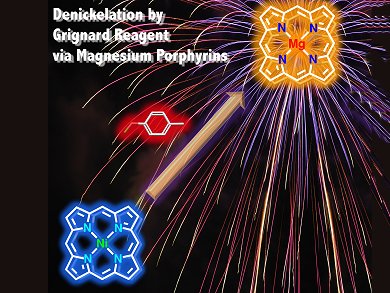Nickel porphyrins are among the most commonly used building blocks for the construction of porphyrin-based architectures, as the diamagnetic nickel allows the ready characterization by NMR spectroscopy. However, nickel-based porphyrins are not useful for photophysical investigations as their photoexcited states decay to the ground state in a matter of picoseconds.
Atsuhiro Osuka and his group, Kyoto University, Japan, have found that treatment of nickel porphyrins with the Grignard reagent 4-methylphenylmagnesium bromide in specific solvents, results in smooth transmetalation of magnesium for nickel. The magnesium can then be removed under mildly acidic conditions to afford the free-base porphyrin.
This two-step methodology can also be applied to porphyrins complexed with other metals. For example, zinc, copper, and silver porphyrins also underwent a Grignard reaction to give the corresponding magnesium porphyrins, but unfortunately this methodology is not applicable to cobalt and palladium. Nevertheless, the demetalation of a variety of metal porphyrins, which is normally achieved only in very strongly acidic conditions, can now be performed much more easily.
- Demetalation of Metal Porphyrins via Magnesium Porphyrins by Reaction with Grignard Reagent,
K. Murakami, Y. Yamamoto, H. Yorimitsu, A. Osuka,
Chem. Eur. J. 2013.
DOI: 10.1002/chem.201301146




